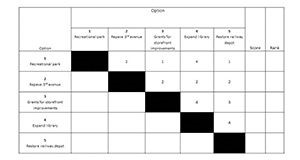Abstract
Matrix ranking is an activity used to analyze and prioritize information. Extension professionals often work with community groups who may benefit from this type of analysis. This 4-page fact sheet explains how Extension professionals can use matrix ranking to facilitate prioritization and decision-making. Written by Keegan Gay, Eric Stubbs, and Sebastian Galindo-Gonzalez, and published by the Department of Agricultural Education and Communication, October 2016.
References
Drinkwater, M. (1993). Sorting fact from opinion: The use of a direct matrix to evaluate finger millet varieties. Rapid Rural Appraisal Notes, 17, 24-28.
Harder, A. (2013). Determining Program Priorities. WC105. Gainesville: University of Florida Institute of Food and Agricultural Sciences. Retrieved April 10, 2015, from http://edis.ifas.ufl.edu/wc105
Hawkins, R. (n.d.). Ranking and scoring - guidelines. International Centre for Development-Oriented Research in Agriculture [ICRA]. Retrieved from: http://www.icra-edu.org/objects/anglolearn/ACFaHt1tC.pdf
Maxwell, S., & Bart, C. (1995). Beyond ranking: Exploring relative preferences in P/RRA. Participatory Learning and Action Notes, 22, 28-34.
Narayanasamy, N. (2009). Participatory rural appraisal: Principles, methods and application. SAGE Publications India. https://doi.org/10.4135/9788132108382
Warner, L. A., & Galindo-Gonzalez, S. (2014). Identifying Key Community Leaders to Assess Extension Programming Needs. AEC500. Gainesville: University of Florida Institute of Food and Agricultural Sciences. Retrieved April 10, 2015, from http://edis.ifas.ufl.edu/wc164 https://doi.org/10.32473/edis-wc164-2014

